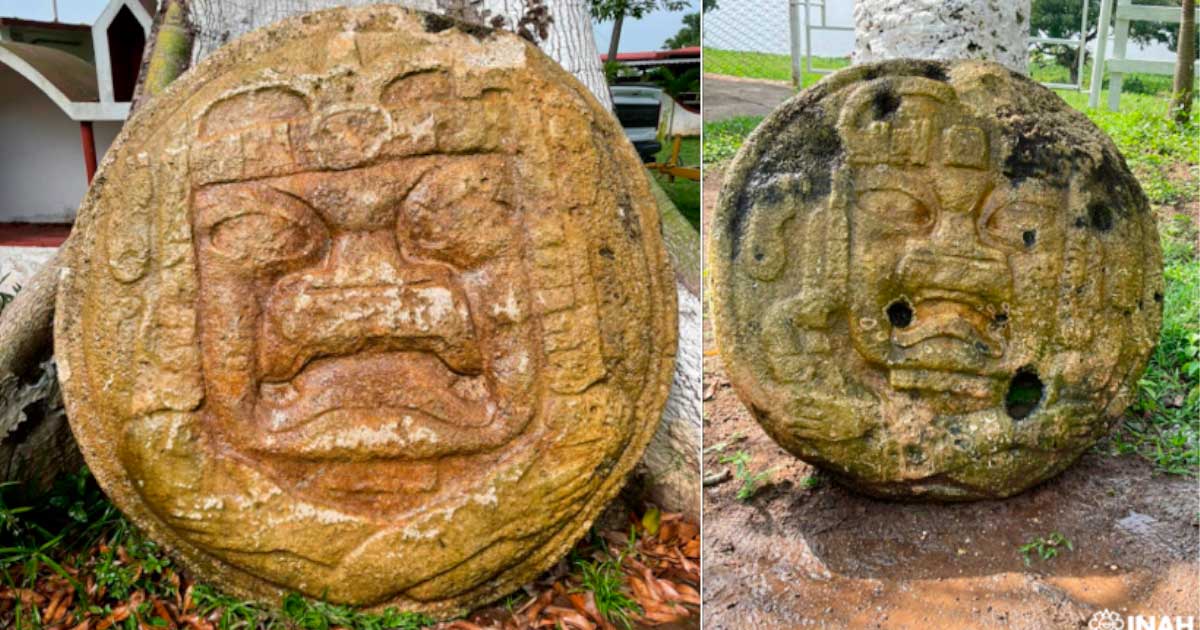Two Huge Stone Olmec Reliefs Depict Rulers in Divine Trance Pose
Massive monuments and two carved limestone Olmec reliefs of local rulers have been recovered from the municipality of Tenosique in south-eastern Mexico. The rulers in this extremely rare Olmec relief style are depicted in a divine trance state in a ritual contortionist pose, which is said to reduce oxygen levels in the brain.
The Olmec Civilization and Two Very Strange Olmec Reliefs
Archaeologists from the National Institute of Archaeology and History (INAH) announced the discovery on Friday, after receiving word from some locals in Tenosique, Tabasco, Mexico.
The large circular limestone Olmec reliefs are about 1.40 meters (4.59 feet) in diameter and show a face with “celestial” jaws, wearing a diadem made from four corncobs and a mirror with the “Olmec cross” in the center.
- The Olmecs: Mesoamerican Mother Culture of Colossal Heads and Giant Mysteries
- Monuments Depicting Olmec 'Descent of the Grandfather' Myth and the Rise of Mayan Writing Found in Guatemala
This cross is marked by a glyph that is associated with the figure of the jaguar, and is traditionally featured in elite Olmec clothing, according to a INAH press release.
On either side of the face are jaguar footprints. The mouth is depicted in the “grumpy mouth” style, which alludes to a jaguar roaring.
Both Olmec reliefs have a square-shaped face with a diadem, which archaeologists have traced to the central Usumacinta region of Mexico, between the mouth of the Chacamax River and the mouth of the San Pedro River.
The Olmecs were an early Mesoamerican civilization and are often referred to as the mother culture of Mesoamerica. The word Olmec derives from the Nahuatl word, Olemactl or Olemecah, which means “rubber people.”
Tenosique, where the two Olmec reliefs were discovered, is located along the Usumacinta River, and was the key region during the Olmec formative period (900-400 BC), reports Heritage Daily.

This is the second of the rare huge contortionist Olmec reliefs found in Tabasco province along the Usumacinta River on new farm land. (INAH)
These Olmec Reliefs Suggest Early Maya Influences
“It is possible that these faces evolved and derived in the Maya ‘ajaw’ altars, such as those of the Caracol site, in Belize, which tells us about the permanence of this theme for more than three centuries, already by the Classic periods. The word ajaw means 'the one who shouts', 'the one who commands', 'the one who orders’ and in these Mayan monuments the mouth stands out, a feature that must come from Olmec times, especially from these circular reliefs of ‘contortionists’ that are portraits of local chiefs,” explained the director of the INAH Tabasco Centre, Carlos Arturo Giordano Sanchez Verin.
He credits the find to a report made by researcher Tomas Perez Suarez, a researcher at the Center of Mayan Studies, of the National Autonomous University of Mexico (UNAM). Suarez cited the existence of these transitional Olmec reliefs in 2019. And the 2022 circular Olmec reliefs are remarkably similar to a circular stone relief discovered at the beginning of 2000 in the Belen district of the town of Tenosique.
The two recently discovered reliefs were found on a property in Villahermosa, the capital of Tabasco, and verified by INAH deputy director, José Luis Romero Rivera. The finds emerged on a ranch during agricultural land levelling, when a worker noticed something sticking out of the ground. Further surveys of the ranch will be carried out soon to determine if there are more artifacts.

The earlier style of carving Olmec heads were more like this example known as Olmec Head San Lorenzo No. 1, sculpted around 1200-900 BC. (Mesoamerican / CC BY-SA 4.0)
Contortionist Olmec Reliefs: The Influence of Mayanization
Specialists in the history of Olmec archaeology have concluded that a stylistic transition took place in Olmec reliefs around 400 BC. At this time, the coastal plains of Tabasco underwent a process of Mayanization (500-300 BC). Over time, this accelerated and entered the domain of Palenque, Chiapas, which clashed with the territory of Mixe-Zoque tribes.
Mayanization can roughly be understood as the cultural and social practices of the mainland that appropriated and subsumed a number of indigenous tribes and their practices.
To date there are only five known contortionist Olmec reliefs. One is from Balancan and on display in the Regional Museum of Anthropology in Villahermosa. Another was found in the town of Ejido Emiliano Zapata, which is now in the INAH Pomona Site Museum. The remaining three were all found in Tenosique (including the two 2022 reliefs, and the one discovered in 2000).
Top image: This is one of the two rare huge Olmec reliefs from 900-400 BC found in the province of Tabasco, Mexico, which signal the transitional Mayanization of Olmec motifs, according to INAH archaeologists. Source: INAH
By Sahir Pandey
References
Heritage Daily. 2022. ARCHAEOLOGISTS UNEARTH ANCIENT OLMEC RELIEFS. Available at: https://www.heritagedaily.com/2022/08/archaeologists-unearth-ancient-olmec-reliefs/144363.
Imagen Radio. 2022. Centro INAH Tabasco recupera dos relieves olmecas de “contorsionistas”, procedentes de Tenosique. Available at: https://www.imagenradio.com.mx/centro-inah-tabasco-recupera-dos-relieves-olmecas-de-contorsionistas-procedentes-de-tenosique.



















